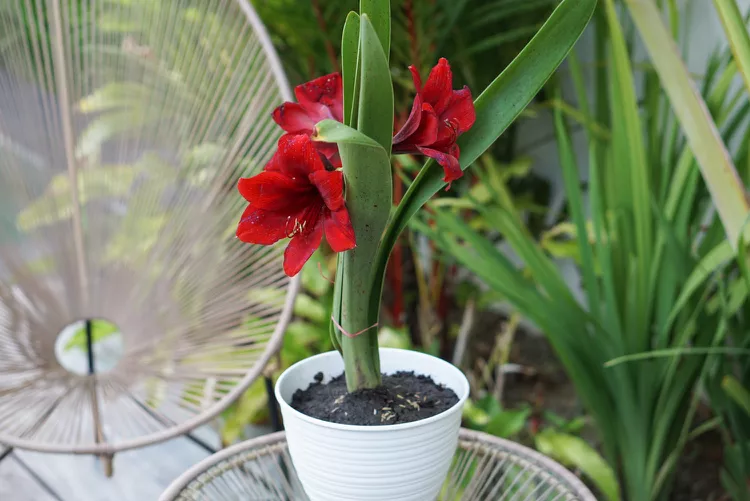
Hippeastrum bulbs tend to be tunicate (a protective dry outer layer and fleshy concentric inner scales or leaf bases). The bulbs typically have a diameter of 5 to 12 cm (2 to 5 inches) and can grow two to seven long-lasting evergreen or deciduous leaves that measure 30 to 90 cm (12 to 36 inches) long and 2.5 to 2 cm (1 inch to 1 inch) wide. The leaves are sessile (borne directly from the stem or peduncle), hysteranthous (develop after flowering), infrequently persistent, and sub petiolate.
The flowers are arranged in pauciflorus or pluriflorous umbelliform inflorescences (2–14 blooms), which are supported on an upright hollow scape (flower stem) that is 20–75 cm (12–30”) long and 2.5–5 cm (1–2”) in diameter. Two free bracts form a bivalve spathe with free leaflets at its base.
Care

Light
If you want your Hippeastrum to produce flowers again the next year, it needs bright light and some sun for part of the day. A lack of light during the flowering stage will also cause the stalks to bend towards the light sources, increasing the likelihood that it will topple over.
Watering
If the plant is brought in a dormant state, water it just enough to keep the soil equally moist, and then wait for growth to resume before watering it once more. Aim to keep the soil moist for the majority of the time when “actively growing” (i.e., when the leaves have fully opened) and the weather is warm. Water should be reduced as you approach autumn and fall and finally stopped altogether.
Never leave a Hippeastrum or Amaryllis bulb “sitting” in water at any moment because doing so can easily lead to decay.
Humidity
Amaryllis and hippeastrum aren’t overly picky about humidity. However, keep in mind that areas with high humidity will require less watering overall than those with high levels of aridity because the potting soil will take longer to dry out.
Feeding
Feed the plant only after the flowers have faded and the leaf straps have appeared on the plant. During the summer, try to feed every two weeks or so, and cease right before autumn or fall arrives. This will aid in the bulb’s “fattening up” so that it is prepared to produce some (hopefully) early spring blooms the following year.
Temperature
Hippeastrum needs a warm environment to start growing if it is not already in bloom or showing blooming shoots when you first obtain it. A dormant bulb can be awakened with warmth and moisture, and if you keep it warm, it won’t take long for flowering stems to start climbing the ceiling.
The flowering time will be quite short if you maintain the same temperature when the flower buds are ready to open and immediately afterwards. Thus, cool things down if you want to limit the overall growth (you might be trying to get it to bloom on a specific date, for example) or want to extend the life of the blooms after they’ve fully opened.
They’ll last longer if kept out of direct sunlight and in a cooler environment, just like a bunch of cut flowers you buy from a store. In light of this, frost must be avoided at all costs because neither Hippeastrum nor Amaryllis will tolerate “cold” temperatures.
Repotting
Repotting your Hippeastrum is only necessary if the plant developed so many offsets that it needed additional space, the pot was too small to begin with, or the potting soil had degraded. It is not necessary to repot bulbs every year or even to take them out of their current pots for the winter.
If you ever decide to repot your plant, make sure the new container is just a tiny bit bigger than the old one and use high-quality compost. Only half of the bulb should be covered; any more will increase the likelihood of the bulb decaying.
Fertilizer
The amaryllis requires a low-nitrogen fertilizer since a fertilizer with a high nitrogen concentration can inhibit bloom development and encourage the growth of the plant’s leaves. For amaryllis plants, a 5-10-10 or 6-12-12 fertilizer is recommended.
Table





